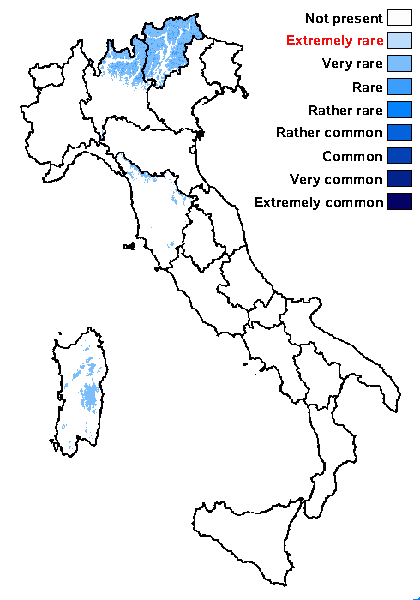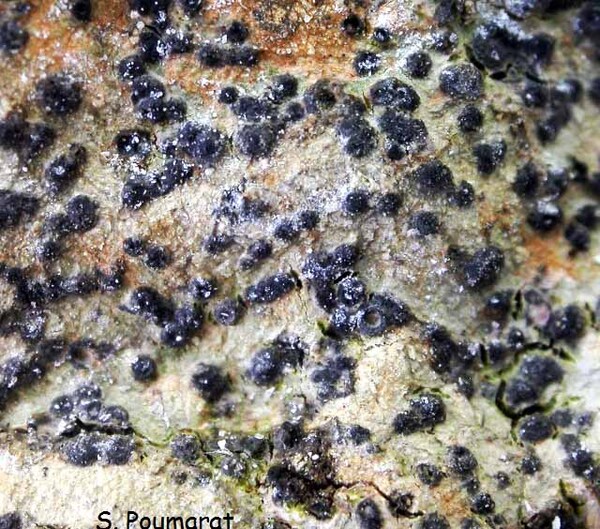Verrucaria submersella Servít
Ceskoslov. Lišejn. Celedi Verrucariaceae: 142, 1954.
Synonyms: Verrucaria submersa Schaer. non Borrer
Distribution: N - TAA (Thüs & al. 2015), Lomb (as V. aberrans Garov). C - Tosc (GDOR 106), Sar (Herb. Nascimbene 4375).
Description: Thallus crustose, episubstratic, 50-150 μm thick, smooth, continuous or sparsely rimose, whitish to grey, not separated by black lines from adjacent conspecific thalli. Cortex poorly developed, sometimes with a brown pigment, otherwise colourless; medulla without a black basal layer. Perithecia half- to 3/4-immersed, leaving shallow pits in the rock, the uppermost part hemispherically projecting, 0.25-0.45 mm wide, the ostiolar area naked. Involucrellum apical or reaching the lower half of the perithecium, but not to base-level, adpressed to exciple in upper part, spreading laterally into the thallus in lower part; exciple 0.2-0.32 x 0.18-0.35 mm, the wall colourless to pale brown; hamathecium of periphyses and periphysoids, interascal filaments absent; hymenial gel hemiamyloid, I+ red (I+ blue at very low concentrations of I), K/I+ blue. Asci 8-spored, clavate, I-, fissitunicate, the wall thickened above, with an ocular chamber, dehiscent by extrusion of an endotunica to form a delicate rostrum, Verrucaria-type. Ascospores 1-celled, hyaline, ellipsoid 20-25(-30) x 9-14 μm, without a gelatinous perispore. Photobiont chlorococcoid, the cells coherent, irregularly arranged. Spot tests: K-, C-, KC-, P-, UV-. Chemistry: without lichen substances.
Note: a calcicolous freshwater lichen, related to V. elaeomelaena and V. funckii, but differing in several morphological characters.
Growth form: Crustose
Substrata: rocks
Photobiont: green algae other than Trentepohlia
Reproductive strategy: mainly sexual
Periodically submerged (e.g. in creeks)
Poorly known taxon in need of further study
Commonnes-rarity: (info)
Alpine belt: very rare
Subalpine belt: rare
Oromediterranean belt: very rare
Montane belt: very rare
Submediterranean belt: absent
Padanian area: absent
Humid submediterranean belt: absent
Humid mediterranean belt: absent
Dry mediterranean belt: absent

Predictive model
Herbarium samples
Growth form: Crustose
Substrata: rocks
Photobiont: green algae other than Trentepohlia
Reproductive strategy: mainly sexual
Periodically submerged (e.g. in creeks)
Poorly known taxon in need of further study
Commonnes-rarity: (info)
Alpine belt: very rare
Subalpine belt: rare
Oromediterranean belt: very rare
Montane belt: very rare
Submediterranean belt: absent
Padanian area: absent
Humid submediterranean belt: absent
Humid mediterranean belt: absent
Dry mediterranean belt: absent

Predictive model
| Herbarium samples |
 INDEX FUNGORUM
INDEX FUNGORUM
 GBIF
GBIF
 DOLICHENS
DOLICHENS



